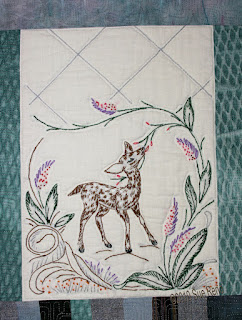Martha says: "The dresser scarf I can recall stitching while pregnant with my daughter, and using, washing and ironing for many years. BTW, I still love ironing--seeing something wrinkled become neat, smooth, and sharp-lined."
These are box elder leaves, with wet process cyanotype and just a bit of Solarfast chemicals mixed in, shown here just before exposure.
For the next print I pulled a deer embroidery from my stash, and used the same mix of chemicals and box elder leaves.
Deer were a very popular subject matter back in the heyday of these embroideries, which were often done from kits, or from patterns in women's magazines. It may have been the Bambi influence, or the fact that many households had deer hunters. I've used a deer embroidery before in a large quilt, adding stitched details.

Here are the prints after exposure, but before rinsing.


I'm kind of in love with this deer print. It gives me the feeling of peeking through the tree canopy to see a doe and fawn resting in a clearing. Again, stitching will add definition.
This one is also special, with a twilight-in-the-garden feel.
Twitter feed: http://twitter.com/suereno
Tumblr: http://suerenostudio.tumblr.com
Instagram: https://www.instagram.com/sue_reno_studio/
For the next print I pulled a deer embroidery from my stash, and used the same mix of chemicals and box elder leaves.
Deer were a very popular subject matter back in the heyday of these embroideries, which were often done from kits, or from patterns in women's magazines. It may have been the Bambi influence, or the fact that many households had deer hunters. I've used a deer embroidery before in a large quilt, adding stitched details.
For the final print in this batch, I used a delicate floral embroidery with a cutwork center that Martha gifted me (but did not stitch). This one has calla lily leaves.

Here are the prints after exposure, but before rinsing.
There's no predicting how the fabric (of unknown fiber, but probably heavy cotton or linen) and the embroidery thread will pick up the chemicals, which is one of the things that I love about these experiments.

The deer print is looking a bit dark at this point, it absorbed a lot of the chemicals.
And this is why I love printing with calla lily leaves, the semi-transparent areas on the leaves leak the light through.

Here are the finished prints.
These two have a very lovely heathered look. When they are stitched to add definition, they are going to be very beautiful in a subtle way.I'm kind of in love with this deer print. It gives me the feeling of peeking through the tree canopy to see a doe and fawn resting in a clearing. Again, stitching will add definition.
This one is also special, with a twilight-in-the-garden feel.
Thanks for viewing!
A reminder that you can follow along on your platform of choice:
Facebook page:http://www.facebook.com/suerenostudioTwitter feed: http://twitter.com/suereno
Tumblr: http://suerenostudio.tumblr.com
Instagram: https://www.instagram.com/sue_reno_studio/











4 comments:
So, just so I understand, you just mix up the chemicals for the cyanotype and then mix in some solar fast? any ratio?
Thanks for sharing your info!
Basically, yes. I measure and mix the cyanotype according to the directions, but wing it with the Solarfast. I’m still experimenting with different ratios, and different colors seem to react differently, which is not surprising. But it doesn’t take much.
Hi Sue!
You have such beautiful work. I am a college printmaking student, and I was interested in using wet cyanotypes (with various chemicals like vinegar, solarfast, turmeric, etc.) for my final show, and was wondering if there was a preferred method to applying the experimental chemicals on the cyanotype? Do you use a spray bottle or pour it directly on the surface for instance? Lovely prints, excited to see what you do in the future!
Best,
Katherine
Hi Katherine, thanks for the kind words! I generally use an inexpensive paintbrush, or a foam brush. Sometimes I use a (kitchen) silicon basting brush, if I'd like more of the brushstrokes to show. Just experiment and see what works for you. Be aware that cloth soaks up a good deal more solution than coating paper. Good luck with your show, it sounds exciting!
Post a Comment